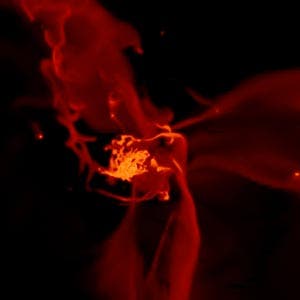
One of the fundamental backbones of the Big Bang theory states that after the rapid expansion of the Universe only the lightest elements were formed. A group of scientists stumbled across an amazing discovery recently when they found a gas cloud dating from the time of the early Universe exclusively made out of hydrogen and helium, proving another solid evidence that supports the current Universe formation model. This is the first time scientists have been able to observe an area without any metallic elements, and thus peek into the early universe.
The two gas clouds weren’t observed directly, but by means of spectral analysis of the light emitted by a distant quasar, which in its travels also happened to pass through these primordial traces of the Universe, estimated at being 13.7 billion years old. The location of the clouds has been estimated at around 2 billion light years away, however they were formed just minutes after the Bing Bang. Amazingly enough, these clouds remained unpolluted by other elements for 2 billion years.
This isn’t however the oldest trace of the Universe found so far. Other discoveries have found objects just one billion years old, but this particular research is of great importance, since it enforces one of the fundamental principles that constitute the Big Bang model, which states that only the first two elements on the periodic table, hydrogen and helium, existed in the very early universe.
“This is very good news because the existence of gas without metal has been predicted by the big bang theory but never observed,” UC Santa Cruz doctoral student Michele Fumagalli, who helped on the study, says. “So the fact that we are seeing these gases there is now empirical evidence that this theory is correct.”
It certainly surprised Christopher Howk, a physics professor at the University of Notre Dame, who wasn’t involved in the study. “I actually was kind of shocked that they found this, because I had kind of given up hope that they would find this anytime soon, especially the way they did.”
All the other heavy elements, like metals, came millions and billions of years later inside of stars.
“When a massive star runs out of its fuel it explodes in a supernovae,” John O’Meara, a professor at Saint Michael’s College in Vermont who was an author on the new study says. “The explosions are so violent that it kicks this stuff [heavy elements] out of the galaxy.”
Incited by this phenomenal find, scientists now are poised to enlist on primordial gas hunts, so that similar pockets of elemental gas can be studied. The research appears in this week’s Science.






